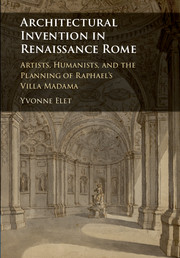 Architectural Invention in Renaissance Rome
Architectural Invention in Renaissance Rome Book contents
- Frontmatter
- Dedication
- Contents
- List of Plates
- List of Figures
- Preface and Acknowledgments
- Note on Translations and Abbreviations
- Introduction: The Nature of Invention, in Word and Image
- 1 Reviving the Corpse
- 2 Writing Architecture
- 3 Sperulo's Vision
- 4 Encomia of the Unbuilt
- 5 Metastructures of Word and Image
- 6 Dynamic Design
- Conclusion: Building With Mortar and Verse
- APPENDIX I Francesco Sperulo, Villa Iulia Medica versibus fabricata/ The Villa Giulia Medicea Constructed in Verse: critical edition and translation by Nicoletta Marcelli and gloss by the Author
- APPENDIX II Francesco Sperulo, Villa Iulia Medica versibus fabricata: Analysis of the presentation manuscript
- APPENDIX III Francesco Sperulo, Ad Leonem X de sua clementia elegia xviiii
- Notes
- Bibliography
- Index
5 - Metastructures of Word and Image
Published online by Cambridge University Press: 06 January 2018
- Frontmatter
- Dedication
- Contents
- List of Plates
- List of Figures
- Preface and Acknowledgments
- Note on Translations and Abbreviations
- Introduction: The Nature of Invention, in Word and Image
- 1 Reviving the Corpse
- 2 Writing Architecture
- 3 Sperulo's Vision
- 4 Encomia of the Unbuilt
- 5 Metastructures of Word and Image
- 6 Dynamic Design
- Conclusion: Building With Mortar and Verse
- APPENDIX I Francesco Sperulo, Villa Iulia Medica versibus fabricata/ The Villa Giulia Medicea Constructed in Verse: critical edition and translation by Nicoletta Marcelli and gloss by the Author
- APPENDIX II Francesco Sperulo, Villa Iulia Medica versibus fabricata: Analysis of the presentation manuscript
- APPENDIX III Francesco Sperulo, Ad Leonem X de sua clementia elegia xviiii
- Notes
- Bibliography
- Index
Summary
MULTIVALENT CONCEPTUAL PROGRAMS
We have seen poets working with architects to build the villa with words, but what exactly were they constructing? Historians of art and architecture usually speak of the program for an ensemble or building, typically in the sense of a description of ideological or iconographic subject matter to be expressed in the work. This notion is problematic for several reasons, beginning with the anachronistic term program itself, which first came into use in the eighteenth century, and in a different context. Sixteenth-century writers referred instead to the notion of invenzione, a term drawn from rhetoric and, confusingly, used to designate conceptual, verbal, or visual ideas. Much of the literature about programs or inventions has focused on painting, and occasionally sculpture, the media most closely associated with the visual formulation of text-based narratives. Our limited knowledge of such programs is based on extant written examples. The survival of a number of programs from the mid-sixteenth century coincides with the taste for increasingly complex, recondite imagery, although this obviously varied by patron and the nature of the commission. Contemporary sources earlier in the century are scarce, and varied in their appreciation of such complexity. Paolo Cortesi, writing in 1510, advocated learned and abstruse decorative schemes for the erudite audiences visiting a cardinal's palace. Although Cardinal Giulio knew Cortesi's work, he specifically expressed his wishes that the imagery for his villa be familiar and straightforward – “so that it is not necessary for the painter to add: ‘this is a horse’.” (Of course, this statement needs to be interpreted in the context of the jocular repartée between the Cardinal and his agent Mario Maffei in Rome, with the understanding that what constituted straightforward imagery for Cardinal Giulio could still seem complex by modern standards.) But there is little evidence about the generation of programs or inventions for the first half of the sixteenth century in general, and for the Raphael school in particular, which may partly reflect a culture of orality, and of collaborators working together face to face.
The notion of a program for architecture is necessarily somewhat different than in representational media; the subject of whether and how verbal ideas could be translated into architectural design has proved to be problematic.
- Type
- Chapter
- Information
- Architectural Invention in Renaissance RomeArtists, Humanists, and the Planning of Raphael's Villa Madama, pp. 99 - 141Publisher: Cambridge University PressPrint publication year: 2018
